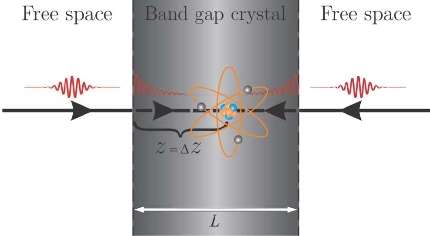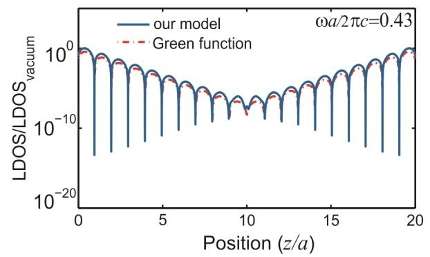Controlling the emission of light? Size matters

In daily life light is often generated by spontaneous emission, for instance, in lighting, in LCD displays, and in DVD players. In this process, an excited quantum emitter, such as an atom, a molecule, or a quantum dot emits a photon. In modern science and technology spontaneous emission is notably being controlled by photonic crystals. Recently a team of scientists from the University of Twente in the Netherlands, have discovered how the size of such photonic crystals controls spontaneous emission.
The scientists have obtained a new understanding on how so-called vacuum fluctuations are inhibited in the photonic crystals. This study paves ways for applications such as efficient LEDs, lasers, and photovoltaics, and even quantum computers where it is desirable to suppress the fluctuations of the qubits. Their theoretical results are being published in the leading journal Physical Review B that is published by the American Physical Society (APS).
According to quantum mechanics, a quantum emitter spontaneously emits a photon after it has been brought to a high energy state. No matter whether the emitter is in free space or in any other medium, such as a piece of glass or in a liquid, it is perturbed by so-called vacuum fluctuations. Although free space seems to be a very quiet place, there exist spontaneous fluctuations of the light called vacuum fluctuations that are running around everywhere. Popularly said, these fluctuations "tickle" the emitter to stimulate to emit a photon. To control the spontaneous emission of the emitter one can change the emitter's environment. An environment such as a photonic crystal can radically control the light propagation. If the emitter is in the band gap of an infinite photonic crystal, spontaneous emission is completely suppressed due to the absence of the vacuum fluctuations.
An infinite crystal?
The number of available vacuum fluctuations at any position determines the rate of the spontaneous emission of the emitter, and is known as the local density of states (LDOS). The LDOS in the band gap of an infinite crystal is zero irrespective of frequency or position. An infinite crystal does not of course exist and all real crystals are finite. Now the question arises: how does a finite photonic band gap crystal control emission?

The Dutch team proposes a new point of view on the band gap: they propose that vacuum fluctuations in free space tunnel in the forbidden range in the crystal. As a result, they arrive at a model for the LDOS that is the modified expression of the LDOS for infinite crystals. The scientists found a remarkable fact that within the band gap of a finite crystal, the LDOS not only decreases exponentially inside the crystal but also depends strongly on frequency and position. Moreover, the LDOS strongly depends on crystal size. Therefore the process of spontaneous emission control with a finite crystal does not only depends on the emission frequency, but also on the crystal size, and position of the quantum emitter in the crystal. Despite much experimental progress in controlling spontaneous emission with real finite photonic crystals, the research field of photonic crystals was still suffering from the lack of theory for the finite size properties. Calculation of the LDOS in the band gap of a finite photonic crystal require a deep understanding of the finite size effects.
The proposed know-how paves the way to understand observations and serves to make the transition of concepts from infinite to finite (real) photonic crystals. This is becoming increasingly important as (3D) photonic crystals develop into practical and commercial applications in modern technologies such as light emitting diodes, lasers, sensors, or in future perhaps even quantum computers.
More information: The paper is entitled "Local density of optical states in the band gap of a finite one-dimensional photonic band gap crystal" and is published online in Physical Review B. (prb.aps.org/abstract/PRB/v89/i4/e045123). The paper will appear in the print volume 89, issue 4, 2014. Also: arxiv.org/abs/1309.5730v2
Journal information: Physical Review B
Provided by University of Twente




















